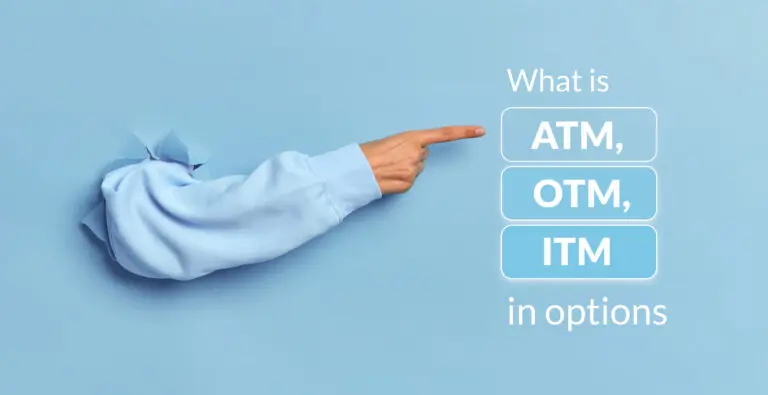
Table of Content
Options trading can be exciting, but only if you know what you’re doing. One of the widely used but misunderstood terms in the world of options is ATM, ITM, and OTM. These three sets of letters hold the secret to how much money you are making or losing on your trades. So if you’re trying to figure out what ATM, OTM, and ITM mean in options, you’ve come to the right place. Understanding these terms allows you to make smarter choices before the expiry date.
An option is In the Money (ITM) if it already has value. Put simply, it would be profitable if exercised immediately.
Call Option: In The Money (ITM) when the strike price is lower than the current market price of the underlying asset.
For example, if Nifty 50 is trading at ₹22,000, and you own a call option with the strike price of ₹21,800, then you are ITM.
Calculation: ₹22,000 – ₹21,800 = ₹200 (Intrinsic Value)
E.g., If Nifty 50 is trading at ₹22,000, and you hold a put option with a strike price of ₹22,200, you’re ITM.
Calculation: ₹22,000 – ₹22,200 = -₹200 (But it’s ITM for a Put)
ITM typically means a more expensive options premium, though the opportunity for returns will be higher as well.
An option is At the Money (ATM) when the strike price is exactly equal to the current spot price of the underlying asset.
This is a common state for options as they hover around their intrinsic threshold, especially close to the expiry date. At this point, the options premium is entirely time-based (no intrinsic value).
E.g., Nifty 50 at ₹22,000, strike price = ₹22,000 ⇒ ATM call or put.
An option is said to be Out of the Money (OTM) when it holds no intrinsic value and would lead to a loss if exercised immediately.
E.g., Nifty at ₹22,000 and strike price = ₹22,300 call ⇒ OTM
E.g., Nifty at ₹22,000 and strike price = ₹21,700 put ⇒ OTM
Though cheaper in terms of premium, OTM options are riskier as they need the price to move favourably before expiry.
Let’s assume the spot price of Reliance stock is ₹2,500:
| Option Type | Strike Price | Option Status | Reason |
| Call Option | ₹2,400 | ITM | Strike < Spot (₹2,500 – ₹2,400) |
| Call Option | ₹2,500 | ATM | Strike = Spot |
| Call Option | ₹2,600 | OTM | Strike > Spot |
| Put Option | ₹2,600 | ITM | Strike > Spot (₹2,600 – ₹2,500) |
| Put Option | ₹2,500 | ATM | Strike = Spot |
| Put Option | ₹2,400 | OTM | Strike < Spot |
This is a straightforward ITM, ATM, OTM example that reflects how options behave with respect to market prices.
| Feature | ITM (In the Money) | ATM (At the Money) | OTM (Out of the Money) |
| Intrinsic Value | Positive value | Zero | Zero |
| Call Option Condition | Strike < Spot | Strike = Spot | Strike > Spot |
| Put Option Condition | Strike > Spot | Strike = Spot | Strike < Spot |
| Premium Cost | Highest | Moderate | Lowest |
| Risk Level | Low (already valuable) | Moderate | High (value may never materialise) |
| Profit Potential | High | Uncertain | Only if price moves strongly in your favour |
This ITM OTM ATM chart is handy to keep around while analysing option strategies.
Knowing ITM, ATM, OTM in options can help you choose the correct strike prices and quantify your risk and reward before entering a trade. Whether you are trading a call option or a put option, understanding these basics can make a significant difference to how profitable you are in the options market.
These are classifications used in options trading to describe whether an option has intrinsic value or not. ITM means it has value, ATM means it’s at breakeven, and OTM means it holds no intrinsic value.
A call option is in-the-money (ITM) if the strike price is lower than the market price of the underlying asset. If the strike is greater than the market price, it’s OTM.
OTM options are usually the cheapest because they have no intrinsic value. ITM options are costlier but offer more reliability.
It aids traders in evaluating the probability of earning a profit prior to the date of expiration. These terms also influence the options premium, making them essential for any strategy.
![]() IIFL Customer Care Number
IIFL Customer Care Number
(Gold/NCD/NBFC/Insurance/NPS)
1860-267-3000 / 7039-050-000
![]() IIFL Capital Services Support WhatsApp Number
IIFL Capital Services Support WhatsApp Number
+91 9892691696
IIFL Capital Services Limited - Stock Broker SEBI Regn. No: INZ000164132, PMS SEBI Regn. No: INP000002213,IA SEBI Regn. No: INA000000623, SEBI RA Regn. No: INH000000248, DP SEBI Reg. No. IN-DP-185-2016, BSE Enlistment Number (RA): 5016
ARN NO : 47791 (AMFI Registered Mutual Fund Distributor), PFRDA Reg. No. PoP 20092018

This Certificate Demonstrates That IIFL As An Organization Has Defined And Put In Place Best-Practice Information Security Processes.